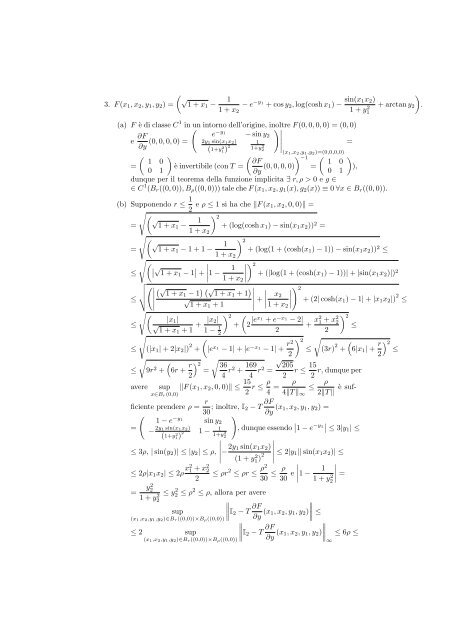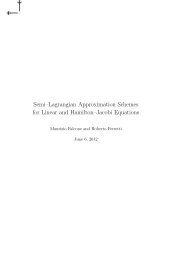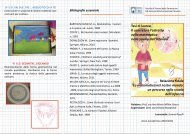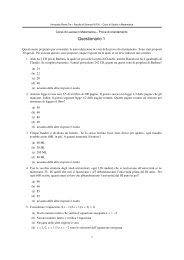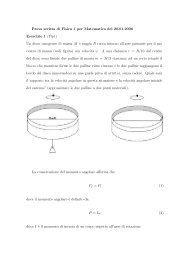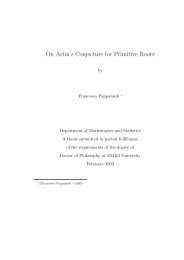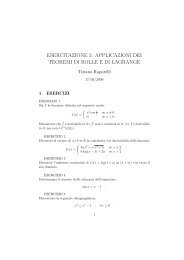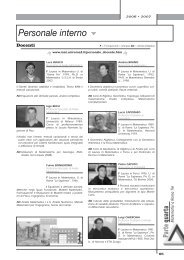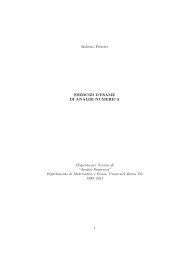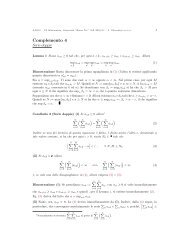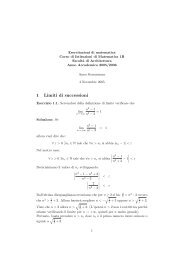Tutorato di Analisi 3 - Dipartimento di Matematica
Tutorato di Analisi 3 - Dipartimento di Matematica
Tutorato di Analisi 3 - Dipartimento di Matematica
You also want an ePaper? Increase the reach of your titles
YUMPU automatically turns print PDFs into web optimized ePapers that Google loves.
( √1<br />
3. F (x 1 , x 2 , y 1 , y 2 ) = + x1 − 1 − e −y1 + cos y 2 , log(cosh x 1 ) − sin(x 1x 2 )<br />
1 + x 2 1 + y1<br />
2 + arctan y 2<br />
).<br />
(a) F è <strong>di</strong> classe C 1 in<br />
(<br />
un intorno dell’origine, inoltre<br />
)∣ F (0, 0, 0, 0) = (0, 0)<br />
e ∂F<br />
∂y (0, 0, 0, 0) = e −y1 − sin y 2<br />
2y 1 sin(x 1x 2) 1<br />
=<br />
(1+y1) 2 2 1+y2<br />
∣∣∣∣(x1,x 2<br />
( )<br />
( ) 2,y 1,y 2)=(0,0,0,0)<br />
−1 ( )<br />
1 0<br />
∂F<br />
1 0<br />
= è invertibile (con T =<br />
0 1<br />
∂y (0, 0, 0, 0) = ),<br />
0 1<br />
dunque per il teorema della funzione implicita ∃ r, ρ > 0 e g ∈<br />
∈ C 1 (B r ((0, 0)), B ρ ((0, 0))) tale che F (x 1 , x 2 , g 1 (x), g 2 (x)) ≡ 0 ∀x ∈ B r ((0, 0)).<br />
(b) Supponendo r ≤ 1 2 e ρ ≤ 1 si ha che ‖F (x 1, x 2 , 0, 0)‖ =<br />
√ (√1<br />
= + x1 − 1 ) 2<br />
+ (log(cosh x 1 ) − sin(x 1 x 2 ))<br />
1 + x 2 =<br />
√ 2<br />
(√1<br />
= + x1 − 1 + 1 − 1 ) 2<br />
+ (log(1 + (cosh(x 1 ) − 1)) − sin(x 1 x 2 ))<br />
1 + x 2 ≤<br />
√ 2<br />
(∣∣<br />
√<br />
≤ 1 + x1 − 1 ∣ +<br />
∣ 1 − 1 ∣) ∣∣∣ 2<br />
+ (|log(1 + (cosh(x 1 ) − 1))| + |sin(x 1 x 2 )|)<br />
1 + x 2<br />
2 (∣ ∣∣∣∣ (√<br />
≤<br />
√ 1 + x1 − 1 ) (√ 1 + x 1 + 1 )<br />
∣ ∣) 2 ∣∣∣<br />
√ 1 + x1 + 1 ∣ + x 2 ∣∣∣<br />
+ (2| cosh(x 1 ) − 1| + |x 1 x 2 |) 2 ≤<br />
1 + x 2<br />
√ (<br />
|x 1 |<br />
≤ √ 1 + x1 + 1 + |x ) 2 (<br />
2|<br />
+ e<br />
1 − 1 + 2 |ex1 −x1 − 2|<br />
+ x2 1 + ) 2 x2 2<br />
≤<br />
2<br />
2<br />
√<br />
2<br />
(<br />
) 2<br />
√<br />
(<br />
≤ (|x 1 | + 2|x 2 |) 2 + |e x1 − 1| + |e −x1 − 1| + r2<br />
≤ (3r) 2 + 6|x 1 | + r 2<br />
≤<br />
2<br />
2)<br />
√<br />
(<br />
≤ 9r 2 + 6r + r )<br />
√<br />
2 36<br />
=<br />
2 4 r2 + 169<br />
√<br />
205<br />
4 r2 = r ≤ 15 r, dunque per<br />
2 2<br />
avere sup ‖F (x 1 , x 2 , 0, 0)‖ ≤ 15<br />
x∈B r(0,0)<br />
2 r ≤ ρ 4 = ρ<br />
≤<br />
ρ<br />
4‖T ‖ ∞ 2‖T ‖ è sufficiente<br />
prendere ρ = r<br />
30 ; inoltre, I 2 − T ∂F<br />
∂y (x 1, x 2 , y 1 , y 2 ) =<br />
( 1 − e<br />
−y 1<br />
)<br />
sin y 2<br />
= 2y1 sin(x1x2)<br />
− 1 − 1 , dunque essendo ∣ ∣<br />
∣1 − e −y1 ≤ 3|y 1 | ≤<br />
(1+y1) 2 2 1+y2<br />
2 ∣ ≤ 3ρ, | sin(y 2 )| ≤ |y 2 | ≤ ρ,<br />
∣ −2y 1 sin(x 1 x 2 ) ∣∣∣∣<br />
≤ 2|y 1 || sin(x 1 x 2 )| ≤<br />
(1 + y1 2)2 ≤ 2ρ|x 1 x 2 | ≤ 2ρ x2 1 + x 2 2<br />
≤ ρr 2 ≤ ρr ≤ ρ2<br />
2<br />
30 ≤ ρ ∣ ∣∣∣<br />
30 e 1 − 1<br />
1 + y2<br />
2 ∣ =<br />
= y2 2<br />
1 + y 2 2<br />
≤ y2 2 ≤ ρ 2 ≤ ρ, allora per avere<br />
sup<br />
∥ I 2 − T ∂F<br />
∂y (x 1, x 2 , y 1 , y 2 )<br />
∥ ≤<br />
sup<br />
∥ I 2 − T ∂F<br />
∂y (x 1, x 2 , y 1 , y 2 )<br />
∥ ≤ 6ρ ≤<br />
∞<br />
(x 1,x 2,y 1,y 2)∈B r((0,0))×B ρ((0,0))<br />
≤ 2<br />
(x 1,x 2,y 1,y 2)∈B r((0,0))×B ρ((0,0))


